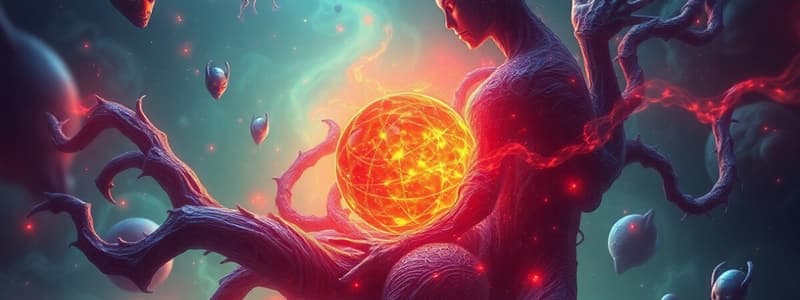Podcast
Questions and Answers
What is the outcome of one complete cycle of beta-oxidation of fatty acids?
What is the outcome of one complete cycle of beta-oxidation of fatty acids?
- 1 NADH and 3 ATP
- 1 NADH and 2 FADH2
- 1 NADH and 1 FADH2 (correct)
- 1 NADH, 1 FADH2, and 2 ATP
Which enzyme is responsible for replacing CoA with carnitine for fatty acid transport into mitochondria?
Which enzyme is responsible for replacing CoA with carnitine for fatty acid transport into mitochondria?
- Acylcarnitine transferase II
- Acyl-CoA synthetase
- Carnitine palmitoyltransferase I (correct)
- Carnitine acyltransferase
What inhibits the function of acylcarnitine transferase I?
What inhibits the function of acylcarnitine transferase I?
- Malonyl CoA (correct)
- Acetyl CoA
- Fatty acids
- Citrate
The total ATP yield from the complete oxidation of lauric acid (C12) is?
The total ATP yield from the complete oxidation of lauric acid (C12) is?
When proteins are catabolized, the first step involves?
When proteins are catabolized, the first step involves?
Acetyl CoA derived from fatty acid oxidation can enter which metabolic cycle?
Acetyl CoA derived from fatty acid oxidation can enter which metabolic cycle?
How many oxidation cycles occur for a fatty acid with 14 carbons?
How many oxidation cycles occur for a fatty acid with 14 carbons?
What does the catabolism of alanine directly produce?
What does the catabolism of alanine directly produce?
What is the role of ATP in the activation of a fatty acid before oxidation?
What is the role of ATP in the activation of a fatty acid before oxidation?
What molecule is produced from the deamination of amino acids during protein catabolism?
What molecule is produced from the deamination of amino acids during protein catabolism?
What is the main function of phospho-fructokinase in glycolysis?
What is the main function of phospho-fructokinase in glycolysis?
Which of the following occurs during the oxidation and ATP formation phase of glycolysis?
Which of the following occurs during the oxidation and ATP formation phase of glycolysis?
In the absence of sufficient oxygen, what does pyruvic acid get converted to?
In the absence of sufficient oxygen, what does pyruvic acid get converted to?
What does the Krebs cycle primarily produce for each acetyl CoA molecule processed?
What does the Krebs cycle primarily produce for each acetyl CoA molecule processed?
Which step in the conversion of pyruvic acid to acetyl CoA involves the removal of a carbon atom?
Which step in the conversion of pyruvic acid to acetyl CoA involves the removal of a carbon atom?
What creates the proton gradient across the inner mitochondrial membrane during oxidative phosphorylation?
What creates the proton gradient across the inner mitochondrial membrane during oxidative phosphorylation?
In glycolysis, what is the initial substrate that is activated?
In glycolysis, what is the initial substrate that is activated?
During ATP synthesis in oxidative phosphorylation, what process allows protons to move back into the mitochondrial matrix?
During ATP synthesis in oxidative phosphorylation, what process allows protons to move back into the mitochondrial matrix?
How many molecules of acetyl CoA are produced from one molecule of glucose during glycolysis?
How many molecules of acetyl CoA are produced from one molecule of glucose during glycolysis?
Which of the following statements regarding the Krebs cycle is true?
Which of the following statements regarding the Krebs cycle is true?
What is the primary function of glycolysis in glucose metabolism?
What is the primary function of glycolysis in glucose metabolism?
Which of the following correctly describes catabolism?
Which of the following correctly describes catabolism?
What is the role of coenzymes like NAD+ and FAD in metabolism?
What is the role of coenzymes like NAD+ and FAD in metabolism?
Which reaction represents the overall oxidation of glucose?
Which reaction represents the overall oxidation of glucose?
In metabolism, what does the term 'endergonic' refer to?
In metabolism, what does the term 'endergonic' refer to?
What happens to energy during the process of anabolism?
What happens to energy during the process of anabolism?
Which statement is true regarding the phases of metabolism?
Which statement is true regarding the phases of metabolism?
During glycolysis, how many ATP molecules are produced from one glucose molecule?
During glycolysis, how many ATP molecules are produced from one glucose molecule?
Flashcards
Metabolism
Metabolism
The sum of catabolism and anabolism
Catabolism
Catabolism
The breakdown of molecules, releasing energy (exergonic).
Anabolism
Anabolism
The synthesis of molecules, requiring energy (endergonic).
Energy Currency
Energy Currency
Signup and view all the flashcards
Glycolysis
Glycolysis
Signup and view all the flashcards
ATP
ATP
Signup and view all the flashcards
Glucose Breakdown
Glucose Breakdown
Signup and view all the flashcards
Metabolic Stages
Metabolic Stages
Signup and view all the flashcards
Rate-limiting step of glycolysis
Rate-limiting step of glycolysis
Signup and view all the flashcards
Pyruvic acid fate (aerobic)
Pyruvic acid fate (aerobic)
Signup and view all the flashcards
Pyruvic Acid (anaerobic)
Pyruvic Acid (anaerobic)
Signup and view all the flashcards
Glycolysis Phase 1
Glycolysis Phase 1
Signup and view all the flashcards
Krebs Cycle Preparatory step
Krebs Cycle Preparatory step
Signup and view all the flashcards
Krebs Cycle (Citric Acid Cycle)
Krebs Cycle (Citric Acid Cycle)
Signup and view all the flashcards
Oxidative Phosphorylation
Oxidative Phosphorylation
Signup and view all the flashcards
Cellular Respiration Summary
Cellular Respiration Summary
Signup and view all the flashcards
Acetyl CoA
Acetyl CoA
Signup and view all the flashcards
Beta-oxidation of fatty acids
Beta-oxidation of fatty acids
Signup and view all the flashcards
Carnitine shuttle
Carnitine shuttle
Signup and view all the flashcards
Protein catabolism
Protein catabolism
Signup and view all the flashcards
Deamination
Deamination
Signup and view all the flashcards
Urea Cycle
Urea Cycle
Signup and view all the flashcards
Amino Acid Catabolism
Amino Acid Catabolism
Signup and view all the flashcards
ATP Production (Fatty Acids)
ATP Production (Fatty Acids)
Signup and view all the flashcards
Malonyl CoA
Malonyl CoA
Signup and view all the flashcards
Liver (Protein Degradation)
Liver (Protein Degradation)
Signup and view all the flashcards
Study Notes
Energy and Metabolism
- Metabolism is the sum of catabolic and anabolic chemical processes.
- Catabolism releases energy (exergonic), anabolism takes up energy (endergonic).
- Proteins break down into amino acids.
- Carbohydrates break down into glucose, fructose, and galactose.
- Fats and lipids break down into fatty acids and glycerol.
- Glycogen breaks down into glucose-6-phosphate.
- Glycolysis converts glucose into pyruvic acid.
- Gluconeogenesis converts noncarbohydrate precursors into glucose.
- Lactic acid is formed during anaerobic respiration.
- Citric acid cycle is a series of reactions where acetyl CoA is broken down.
- Electron transport chain produces a large amount of ATP.
- Synthesis of larger molecules (anabolism) requires energy.
- Proteins are created from amino acids.
- Carbohydrates are synthesized into starch.
Common Intermediate in Metabolism
- Several molecules converge into a common intermediate, acetate (acetyl-CoA).
- This intermediate fuels various anabolic pathways.
- Examples of end products include steroids, hormones, and carotenoids.
Two Phases of Metabolism
- Catabolism occurs through degradative and oxidative, converging pathways.
- Anabolism uses biosynthetic and reductive pathways, diverging in product synthesis.
Energy Currency in Metabolism
- ATP is the energy currency of the cell.
- ADP and AMP are related to energy storage.
- Coenzymes such as NAD+ and FAD accept hydrogen or electrons, which are used in ATP production.
Cellular Respiration: Overview
- Glucose is oxidized to yield energy in the form of ATP.
- The process occurs in three main stages: glycolysis, transition reaction, and citric acid cycle followed by the electron transport chain.
- Glycolysis produces a net gain of two ATPs.
- The transition reaction converts pyruvate into acetyl CoA.
- The citric acid cycle produces CO2 and electron carriers.
- The electron transport chain generates a large amount of ATP from electrons.
- The overall reaction is C6H12O6 + 6O2 → 6H2O + 6CO2 + 36 ATP + heat (AG = -686 kcal/mol).
Glycolysis
- The first stage of glucose catabolism.
- No oxygen required.
- Occurs in the cytoplasm.
- Converts 6C glucose into two 3C pyruvates.
- Produces a small amount of energy (2 ATP).
- Pathway regulated according to cellular needs.
Fate of Pyruvic Acid
- Pyruvic acid from glycolysis is converted to acetyl coenzyme A for the Krebs cycle.
- Occurs in three steps: decarboxylation, oxidation, and formation of acetyl CoA.
Krebs Cycle
- An eight-step cycle that oxidizes acetic acid, generates three NADH+H+ and FADH2, and two CO2 molecules.
- Produces one ATP molecule.
- For each glucose molecule entering, two molecules of acetyl CoA enter the Krebs cycle.
Oxidative Phosphorylation
- Hydrogen ions are pumped across the inner mitochondrial membrane to create a proton gradient.
- Electrons are passed along the electron transport chain to oxygen.
- Diffusion of hydrogen ions back across the membrane via ATP synthase releases energy for ATP production.
ATP Production
- Total net ATP yield: 36 or 38 ATP molecules per glucose molecule (theoretical).
- Exact number can vary depending on the cell type.
Lipid Catabolism
- Lipids are broken down into fatty acids and glycerol.
- Fatty acids undergo B-oxidation to produce acetyl CoA.
- Glycerol enters glycolysis.
- Acetyl CoA is a crucial fuel for the Krebs cycle, which produces ATP.
Protein Catabolism
- Proteins are broken down into amino acids by hydrolysis.
- The amino group is removed via deamination, producing ammonia.
- The remaining molecules enter the Krebs cycle for energy generation.
- The ammonia is converted to urea for excretion.
Cori Cycle
- The liver and muscles work together in the Cori cycle to recycle lactic acid.
- Lactic acid produced by muscles during anaerobic respiration is transported to the liver, where it is converted back into glucose.
- This glucose is then transported back to the muscles for use in energy production.
Studying That Suits You
Use AI to generate personalized quizzes and flashcards to suit your learning preferences.




